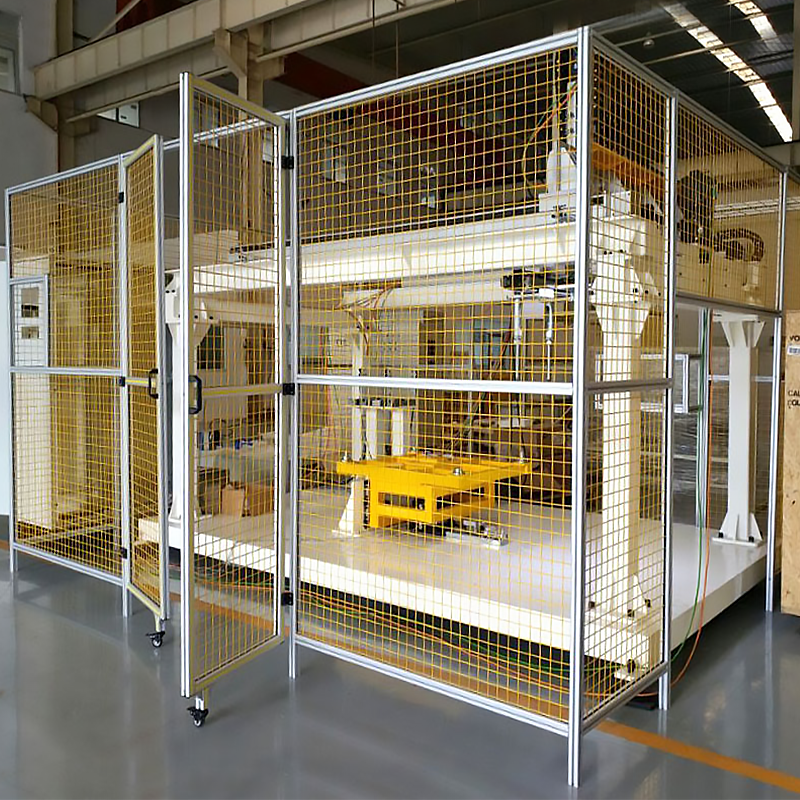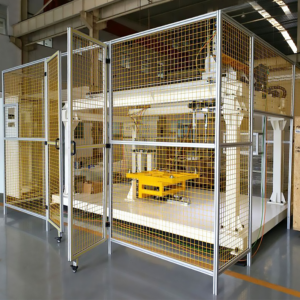Each Machine Guarding Fence is engineered to your exact specifications. Whether protecting transmission parts, shielding hazardous sections, or outlining pedestrian pathways, our customizable fences are versatile enough to cater to a wide array of protective needs.
Description
Custom Machine Guarding Fence
 Industrial aluminum fences are a protective device designed to shield machine tools and equipment from environmental elements. Typically crafted from metals like aluminum alloy or steel, it boasts excellent resistance to oxidation, corrosion, and high temperatures. The fence efficiently blocks dust, debris, and other contaminants, thus enhancing machinery longevity and boosting productivity.
Industrial aluminum fences are a protective device designed to shield machine tools and equipment from environmental elements. Typically crafted from metals like aluminum alloy or steel, it boasts excellent resistance to oxidation, corrosion, and high temperatures. The fence efficiently blocks dust, debris, and other contaminants, thus enhancing machinery longevity and boosting productivity.
Tailor-made to fit customer specifications, Aluminum Profile Protection Fences are staple features in workshops, storage facilities, and large-scale automated industries. With robots becoming commonplace on assembly lines, there’s a growing need for protective enclosures or barriers.
These fences play multiple significant roles, such as creating safe zones to prevent mishaps within workshops—places prone to accidents involving machinery. By enveloping equipment or hazardous zones, these fences offer a secure space, protecting personnel from inadvertently entering unsafe areas.
In warehousing, the fence supports systematic storage and personnel safety by demarcating storage zones, passages, and workspaces. Thus mitigating the risks associated with disorganized stacking. They also safeguard sensitive or private items, deterring unauthorized contact or theft.
For enterprises with intricate automation processes, these fences construct safe interaction zones between staff and machinery, maintaining necessary separation to reduce accidents and augment both safety and operational efficacy.
Aluminum Profile Protection Fences are popular in the automation sector for several reasons:
1. They exemplify ease of assembly and flexibility in design, allowing for a customized, modular construction that can suit a variety of needs while maintaining an aesthetic appeal.
2. Their superior wear and oxidation resistance, courtesy of an oxide film on the aluminum surface, means they are more resilient and long-lasting—up to 25 years—compared to other materials.
3. The fences are highly adaptable. We can equip them with various functional additions such as automated doors, ventilation systems, mobile casters, and control systems depending on the application. Specialized attachments, like anti-arc plates in robot welding stations, not only block contaminants but also dampen intense light and noise, minimizing direct exposure of workers to robots and curtailing safety incidents.
In factories, Aluminum Profile Protection Fences enhance spatial efficiency, streamline management processes. Besides, safeguard machinery and operator wellbeing, and ease the movement and examination of goods and equipment.
 Scenarios of Industrial Aluminum Fences in Life
Scenarios of Industrial Aluminum Fences in Life
Aluminum profile industrial fences, we also call it industrial fences. People mainly use them around mechanical equipment and can play a protective role. The overall structure of the industrial aluminum profile frame is made of industrial aluminum profiles and plates. We can customize it flexibly according to production needs and used in different scenarios.
1. Robot protection equipment.
For safe operation, it is necessary to install industrial fences around robots or equipment to protect them. If the working noise of the robot or equipment is relatively high, a closed fence can be made to reduce noise and purify the working environment.
2. Around airport stations.
There are some places where people are prohibited from entering airports and stations. Installing industrial aluminum profile fences can reduce the entry of outsiders and reduce the occurrence of safety accidents. Industrial aluminum profile fences do not require welding and are easy to install and disassemble.
3. Factory workshops
Industrial fences are often used in factory workshops. Because the factory has limited area, people and items are in one workshop. At this time, we can use installing industrial aluminum profile fences as partitions to divide the use area for easy management and operation.
4. Schools and hospitals.
Both schools and hospitals have a large flow of people, and aluminum profile industrial fences play a good role in transfer. At the same time, we do not need to pain aluminum profiles. Also do not produce gases such as formaldehyde, which is both healthy and environmentally friendly.
Three Types:
1. No-entry safety fence
The purpose is to prevent approach and contact with dangerous parts, and the height is mostly higher than 1200mm. People generally use this kind of fence for the protection of mechanical equipment.
2. Handrails/escalators to prevent falling
This is a fence to prevent falling from heights, and the height is mostly higher than 1100mm.
3. Regional division industrial fence
This kind of industrial aluminum profile fence, we use it to divide areas. And the height can be different according to different places of use.
As industrial progress surges forward, the adoption of large-scale machinery and equipment has become increasingly widespread. To enhance operational ease and minimize incidents, fencing has emerged as an essential tool in factory settings—known commonly as workshop fences. These barriers are a frequent sight surrounding machinery, serving the primary purpose of shielding production staff from hazardous areas and preventing injuries caused by operating equipment.
Industrial aluminum profile workshop fences are ideally suited for various applications within manufacturing environments. They provide protection and act as barriers around the moving parts of machinery, high-risk areas, and company pedestrian pathways. These fences are also perfect for segregating operating platforms, encircling pits, and securing locations where there is a danger of falling, ensuring a safer workplace for all.


 Scenarios of Industrial Aluminum Fences in Life
Scenarios of Industrial Aluminum Fences in Life


